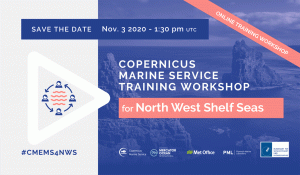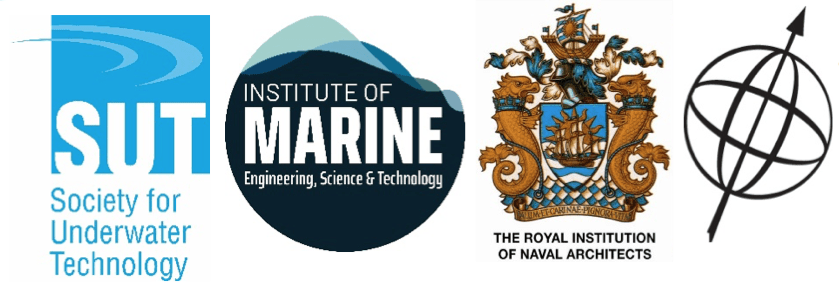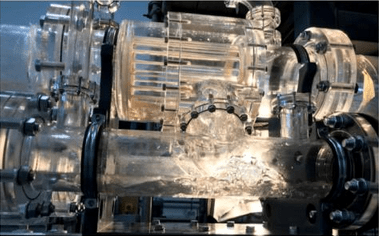13:30 – 14:30
Presented by Robbie Brady and Danny Coles
The Tidal Stream Industry Energiser Project, known as TIGER, is an ambitious €46.8m project, of which €28m (69%) comes from the European Regional Development Fund via the Interreg France (Channel) England Programme. This is the largest ever Interreg project and will prove to be game-changing for the European tidal stream energy sector.
After registering, you will receive a confirmation email containing information about joining the meeting.

Mercator Ocean international, the UK Met Office, Plymouth Marine Laboratory and BSH (Federal Maritime and Hydrographic Agency) are organizing the Copernicus Marine Service Online Training Workshop dedicated to the North West Shelf Seas on November 03 2020 – 1:30 pm UTC.
CONTEXT
The online Copernicus Marine Training sessions have been designed to train existing as well as new Copernicus Marine Service users. The audience will learn about the use of the Copernicus Marine Service products and services and their possible applications.
The acquisition of knowledge during the workshop will allow the public to
Copernicus marine products are open-access and free for all to use.
OBJECTIVES OF THE WORKSHOP ARE TO:
The workshop aims to bring together experts and users of marine products. It will consist of a mixture of plenary expert talks, round table discussions and hands-on practical exercises to explore the Copernicus Marine products catalogue. The target audience is mainly beginners and new users.
By the end of this training event you will be able to:
- Describe the potential value of using Copernicus Marine products.
- Identify relevant Copernicus Marine products that would be appropriate for you to use.
- Navigate the Copernicus Marine product catalogue.
- Confidently use appropriate tools and products from the catalogue.
- Provide inputs for future design and development of Copernicus Marine Service tools and products.
Click here for full information and to book
We invite you to attend the next OSIGp GeoForum on Thursday 12 November at the State Library of WA.
The event will feature the following presentations and be chaired by Raffaele Ragni, NGI.
- Post-Fukushima Fault Studies for Nuclear Power Safety in California, USA
Bryan Bergkamp, Senior Geoscientist, Fugro
- Emphasising an integrated geophysical and geotechnical assessment
Fiona Fitzpatrick, Geohazards Consultant, RPS AAP (Energy), Perth
- Seafloor pockmarks and submarine landslides: insight from the Northern Carnarvon Basin (Australia’s North West Shelf)
Rosine Riera , Geologist, NGI
Please register here
View the full flyer and details here
Read the post-event report
12:00 – 13:00
Hieu Le, Senior Naval Architect at Atkins
Hieu Le will present about the Offshore Wind industry, discussing various types of offshore wind substructures (monopiles, jackets, floating foundations) with examples from the Flagship projects that Atkins have been involved in. Hieu Le is a senior naval architect from Atkins with 7-year experience in both Oil & Gas and Offshore Wind industries. He’s an advocate for the increasing use of LNG and renewable energy in the energy mix.
Register in advance for this meeting:
After registering, you will receive a confirmation email containing information about joining the meeting.
 This meeting has been organised by the NECJB of IMarEST& RINA and will be hosted on IMarESTTV. Presentations will commence at 5.00pm, followed by questions and closing ~6:30pm.
This meeting has been organised by the NECJB of IMarEST& RINA and will be hosted on IMarESTTV. Presentations will commence at 5.00pm, followed by questions and closing ~6:30pm.
Click here to register for this FREE event.
Our inaugural technical meeting of members from the North East Coast Joint Branch (NECJB) of IMarEST and RINA in association with the NI together with the North Branch of the SUT.
We will delve into the latest design, construction, and operations of ship-shaped offshore installations with four interlinked presentations moving from the shipyard to the seabed:
- Are offshore installations a shipyard business? – Paul Stott
- The Drivers and Challenges in the Design of Floating Offshore Assets – Keith Hutchinson
- A Review of Mooring System Solutions for Floating Offshore Assets – Jon Dunstan
- Surface to Seabed: Integrating Well Control, Processing and Subsea Infrastructure – Alan Dobson
Paul Stott is a senior lecturer at Newcastle University. A naval architect by profession, Paul’s expertise is in the interface between marine industries and markets, in particular competitiveness and price/subsidy.
Keith Hutchinson is a ship designer and naval architect at Safinah Group. He is at the forefront of the latest technical developments in the sector, with specific expertise in large floating oil and liquified gas facilities.
Jon Dunstan is managing director of London Marine Consultants. He has extensive experience of the design, construction, installation, operation, maintenance and decommissioning of large fixed and floating offshore oil and gas facilities.
Alan Dobson is a chartered mechanical engineer at TechnipFMC. He is currently in charge of Umbilical and Cable Research and Technology Governance.
North of England events are kindly sponsored by:

We invite you to attend our next OSIGp Lunchtime Technical Meeting on Tuesday 2oth October at 12 noon.
The meeting From Satellite to Microscopic Images: Zooming into Australia’s North West Shelf Calcareous Sediments will feature the following presentations:
- Imaging the seafloor: Toward a regional high-resolution bathymetry of the North West Shelf
Ulysse Lebrec, PhD Candidate, University of Western Australia / Norwegian Geotechnical Institute
- How biology and geological history impacts calcareous sediment geotechnics
Ryan Beemer, Assistant Professor, University of Massachusetts Dartmouth
This is a FREE event for both members and non-members.
View the flyer here
Register here
Notice is hereby given that the Annual General Meeting of the Society for Underwater Technology will be held at
1400hrs GMT on Monday 14 December 2020, online via Zoom. Click here to register..
Statutory Business
.
1. To receive and approve:
(a) the Society’s Accounts for the year ended 30 June 2020, and the Auditor’s Report thereon;
(b) the Reports of Council and of the Educational Support Fund for the same period.
.
2. To declare the appointment of Auditors, and to authorise Council to determine the remuneration of the Auditors.
.
3. To receive a report on:
(a) the election of Officers of the Society;
(b) the election of Members of Council
.
4. To transact any other business.
.
5. To present certificates to newly elected Fellows.
.
6. Awards Ceremony
The Lennard-Senior Prize
Fellows Awards
.
7. Technical Presentation – Anatomy of a pro-bono shipwreck search: HMT Empire Windrush – David L. Mearns
.
Please Note: Only Members of the SUT (Individual Members and Corporate ‘named’ persons) are allowed to attend the AGM. There is no charge for the event.
.
Register in advance for this meeting:
.
After registering, you will receive a confirmation email containing information about joining the meeting.
Online Event from: 8 October (13:30) – 9 October (12:45),2020
Influence, educate and unlock opportunities: Informing global sustainability challenges
Click here for the agenda.
Join us at this eighth Society for Underwater Technology (SUT) and Marine Alliance for Science and Technology for Scotland (MASTS) Salvage, Decom and Wreck Removal Workshop. This year we are bringing together a range of international expertise across the ‘Triple Helix’ of industry, science and government, to build a shared understanding of the ecosystem impact of anthropogenic activity, particularly in the Arctic and Greater North Sea OSPAR area. Focus will be on shipping (including offshore vessels), oil and gas, and wind and wave energy, as actors within the same space. Engineers, scientists, salvors, operators, regulators, NGOs, insurers, lawyers, and other users of the sea will consider sustainability taking a holistic lifetime approach.
Topics include:
- Consistent Decision-Making
Building on the recommendations of the UK Foresight Future of the Sea Report (2018), the specific issue of fragmentation across government and regulatory bodies will be addressed. Currently, there are different limitations and acceptance criteria for industries operating in the same locale. OSPAR’s role/responsibility in remedying this will be explored.
- Climate Change and Sustainability Challenges
Climate change will have an impact on the natural environment, potentially increasing risk to all sectors, including decom. and wreck removal. How do we quantify and mitigate these impacts and risks, and how do we understand our contribution to climate change? The latest academic knowledge, research, and sector experience will evaluate these pressing matters.
- Simulation, Visualisation & Geo-Spatial Data
Reliable data that is contextually nested within time and space is essential for good decision-making. A demonstration of the advances in the remote acquisition of centrimetrically accurate, geo-located data will be shown live, with audience participation to demonstrate the power of imported digital twins and simulation in determining optimal ‘Solutions Choice’.
- Impact of Explosives
A new impact assessment model will be unveiled, and the pros and cons of cutting options discussed, with particular focus on Unexploded Ordnance (UXOs) and ecosystem impact.
Please visit https://hopin.to/events/masts-asm-2020 for information and registration.
CPD certificates of attendance will be available from the SUT.
For information contact: Karen Seath [email protected] 07872 109103
Click here for the flyer.
 13:00 – 14:30 BST
13:00 – 14:30 BST
Pseudo Dry Gas System – An enabling technology for remote gas fields
An overview of an Oil and Gas Technology Centre (OGTC) study to consider the economic impact of applying the innovative Pseudo Dry Gas technology to known stranded gas fields to the North of Shetland islands, making a gas gathering corridor stretching 200km and 1.7km deep. The scope included a detailed flow assurance analysis, and integrated asset modelling for multiple development options to determine the estimated total recovery. This study was supported by data from the UK Oil and Gas Authority.
The presentation will show the comparative study for a known stranded gas basin for a range of development options based on current and near-future technology in order to demonstrate the value proposition and CO2 emission reduction of the Pseudo Dry Gas technology.
The second part of this presentation will be in regards to the undergoing initial prototype testing at Cranfield University and how this relates to the study work carried out to date.
Presenter: Lee Thomas, Intecsea
A subsea engineer with 17 years’ experience in subsea engineering. Beginning his career at BP, through FosterWheeler and now INTECSEA for the last 10 years and has been involved with a number of the longest subsea gas tiebacks currently in operations. He is one of the two co-inventors of the pseudo dry gas technology and has been part of the development team since inception.
This event is free to attend, but registration is essential.
Click here to register
After registering, you will receive a confirmation email containing information about joining the meeting.

 This meeting has been organised by the NECJB of IMarEST& RINA and will be hosted on IMarESTTV. Presentations will commence at 5.00pm, followed by questions and closing ~6:30pm.
This meeting has been organised by the NECJB of IMarEST& RINA and will be hosted on IMarESTTV. Presentations will commence at 5.00pm, followed by questions and closing ~6:30pm.
 13:00 – 14:30 BST
13:00 – 14:30 BST